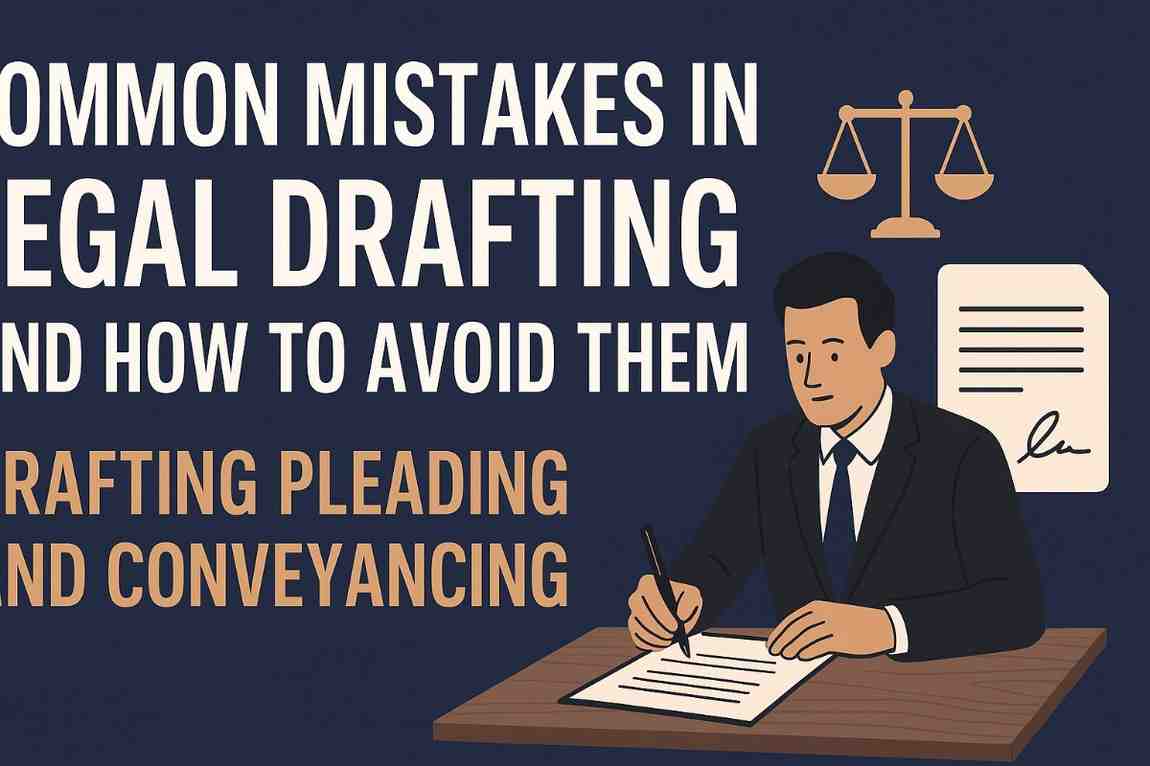


This article explores the most frequent mistakes in legal drafting and provides actionable strategies to avoid them.
Legal drafting is the backbone of effective law practice. Whether it involves drafting contracts, pleadings, or property documents, precision and clarity are crucial. Mistakes in legal drafting can lead to misinterpretation, legal disputes, or even outright rejection of documents in courts. Lawyers, law students, and professionals engaged in drafting pleading and conveyancing must be aware of common errors to ensure their documents are both legally sound and practically effective. This article explores the most frequent mistakes in legal drafting and provides actionable strategies to avoid them.
Legal drafting is more than just writing. It is the art of converting legal concepts, rights, and obligations into structured, unambiguous documents. Whether drafting a sale deed, drafting pleadings for a civil suit, or preparing agreements, errors can have severe consequences. Poor drafting can result in:
In drafting pleading and conveyancing, even minor mistakes, such as misused clauses or unclear language, can jeopardise the entire legal transaction or case. Therefore, understanding common pitfalls is critical for anyone involved in legal documentation.
One of the most common errors in legal drafting is the use of vague or ambiguous language. Legal documents must be clear and precise. Ambiguity can lead to disputes and differing interpretations, which may weaken a client’s position in court or in property transactions.
How to Avoid:
Every document, whether it’s a pleading, contract, or conveyance deed, must comply with statutory requirements. Overlooking these can render a document invalid.
How to Avoid:
A poorly structured document can cause confusion. Courts and other legal authorities expect documents to follow a logical flow: introduction, definitions, body clauses, and conclusion.
How to Avoid:
In legal drafting, using inconsistent terms for the same entity, party, or concept can create contradictions. For instance, referring to a “buyer” as “purchaser” in one clause and “transferee” in another can lead to misinterpretation.
How to Avoid:
Legal drafting in India must consider jurisdictional and procedural requirements. In pleadings, missing procedural references or filing in the wrong format can result in rejection. Similarly, in conveyancing, failure to comply with local stamp duty and registration laws can invalidate a transaction.
How to Avoid:
Some drafters attempt to cover every possible scenario by creating overly complex clauses. While thoroughness is important, overly complicated sentences can obscure meaning and invite disputes.
How to Avoid:
Effective drafting anticipates potential disputes and includes provisions to resolve them. Failing to foresee conflicts in agreements or pleadings can leave parties vulnerable.
How to Avoid:
Even experienced lawyers may overlook errors such as typos, missing dates, or incorrect references. Such mistakes can undermine credibility or affect enforceability.
How to Avoid:
Many lawyers rely on old templates without adapting them to current legal requirements. This practice can lead to outdated clauses or irrelevant references.
How to Avoid:
To excel in drafting pleading and conveyancing, lawyers and legal professionals should adopt the following best practices:
Start with a Clear Outline – Define the purpose, parties, and key clauses before drafting.
Use Legal References – Cite relevant sections from statutes, case laws, or rules to strengthen documents.
Maintain Simplicity and Clarity – Avoid unnecessary legalese and ensure every clause is readable.
Double-Check Legal Compliance – Verify adherence to statutory, procedural, and jurisdictional requirements.
Leverage Professional Resources – Use law books, bare acts, and reference materials to support drafting.
Proofread and Peer Review – Always have documents reviewed before finalization.
For lawyers, law students, and professionals involved in drafting pleading and conveyancing, access to reliable legal resources is indispensable. LexisNexis provides a comprehensive range of bare acts, commentaries, and law books, offering authoritative guidance on Indian laws. Using such resources ensures that your drafts are accurate, compliant, and in line with current legal standards.
Mistakes in legal drafting are common but avoidable. Ambiguity, inconsistent terminology, outdated templates, and a lack of procedural knowledge are among the most frequent errors that can compromise pleadings, agreements, and conveyance documents. By adopting careful planning, using authoritative resources, and prioritising clarity, legal professionals can create documents that are precise, enforceable, and effective.
Whether you are drafting a civil suit, preparing a contract, or completing a property transaction, vigilance in drafting pleading and conveyancing is key to legal success. With the right knowledge, practice, and resources like LexisNexis, lawyers can avoid common pitfalls and ensure their legal documents serve their intended purpose without legal complications.
